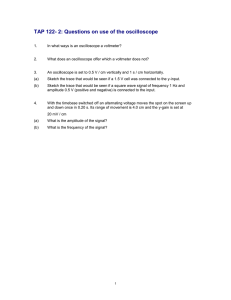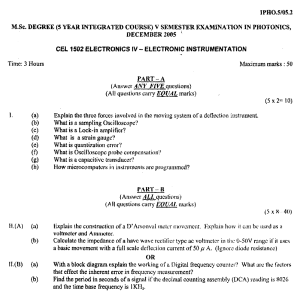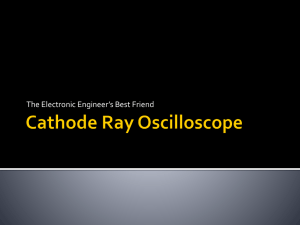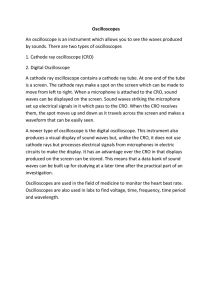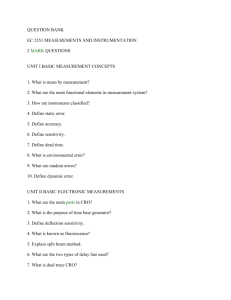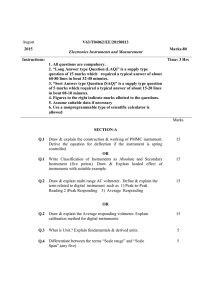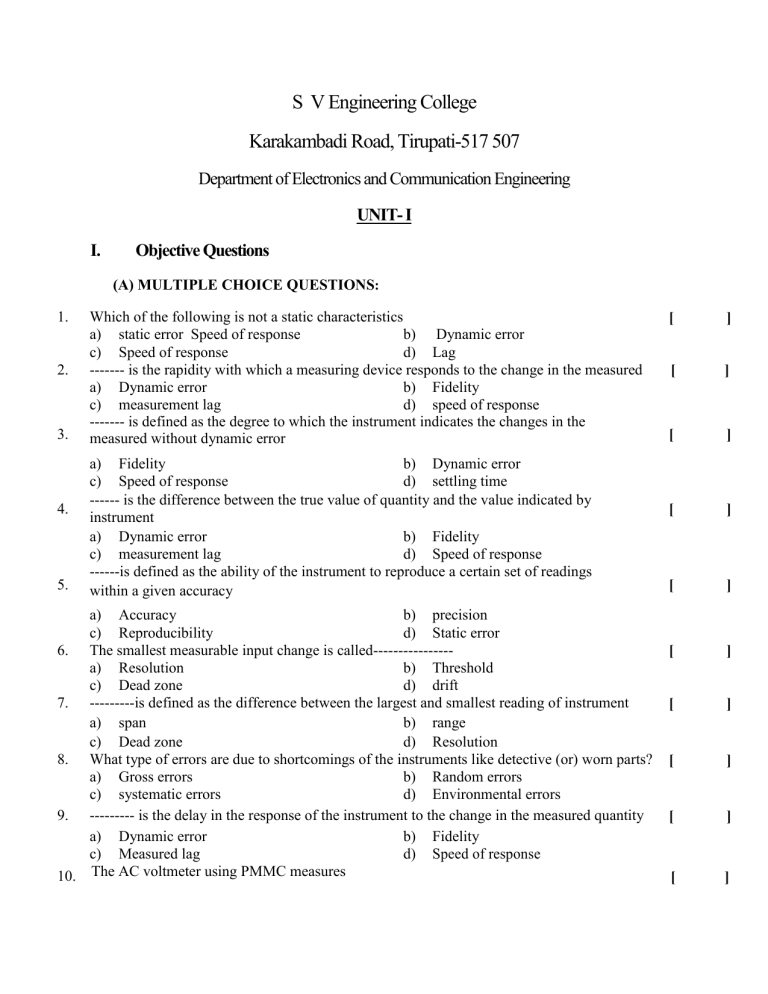
S V Engineering College Karakambadi Road, Tirupati-517 507 Department of Electronics and Communication Engineering UNIT- I I. Objective Questions (A) MULTIPLE CHOICE QUESTIONS: 1. 2. 3. 4. 5. Which of the following is not a static characteristics a) static error Speed of response b) Dynamic error c) Speed of response d) Lag ------- is the rapidity with which a measuring device responds to the change in the measured a) Dynamic error b) Fidelity c) measurement lag d) speed of response ------- is defined as the degree to which the instrument indicates the changes in the measured without dynamic error a) Fidelity b) Dynamic error c) Speed of response d) settling time -----is thewithout difference between the true value of quantity and the value indicated by measured dynamic error instrument a) Dynamic error b) Fidelity c) measurement lag d) Speed of response ------is defined as the ability of the instrument to reproduce a certain set of readings within a given accuracy a) Accuracy b) precision c) Reproducibility d) Static error 6. The smallest measurable input change is called---------------a) Resolution b) Threshold c) Dead zone d) drift ) ) and smallest reading of instrument 7. ---------is defined as the difference between the largest a) span b) range c) Dead zone d) Resolution 8. What type of errors are due to shortcomings of the instruments like detective (or) worn parts? a) Gross errors b) Random errors c) systematic errors d) Environmental errors 9. --------- is the delay in the response of the instrument to the change in the measured quantity a) Dynamic error b) Fidelity c) Measured lag d) Speed of response The AC voltmeter using PMMC measures 10. [ ] [ ] [ ] [ ] [ ] [ ] [ ] [ ] [ ] [ ] a) True RMS voltage b) c) Average voltage d) Peak voltage value Instantaneous (B).FILL IN THE BLANKS: 11. -------------is the delay in the response of the instrument to the change in the measured quantity 12. --------is defined as the largest change in input quantity for which there is not output of the instrument 13. Gross errors occur due to--------------------------14. The smallest measurable input change is called---------------15. A measure of the consistency or repeatability of measurement is known as ……….. 16. --------- is defined as the difference between the largest and smallest reading of instrument 17. …… are the type of errors are due to shortcomings of the instruments like detective (or) worn parts? 18. …… type of errors are due to largely human errors like misreading of instruments 19. A digital voltmeter has a readout range from 0 to 9,999 counts. Determine the resolution-----A 1mA ammeter has a resistance of 100 Ω. It is to be converted to a 1A ammeter. The value of shunt 20. resistance is --------------------- (C) True or False: 21. resistance Variance = is1/(--------------------Standard deviation)2 22 A set of readings has a wide range and therefore it has High accuracy 23 The true RMS voltmeter measures Instantaneous value 24 Static errors occurs due to human mistakes 25 A D’Arsonval Movement is Moving Iron type [ ] [ [ [ [ ] ] ] ] II .Descriptive Questions: (a) 2 Marks Questions 1. Define – Static characteristics of an instrument (Nov/Dec 2011) 2. Define any two dynamic characteristics of an instrument (May/June 2016) 3. Compare the terms ‘Accuracy and Precision’(May/June 2017) 4. Define the term Instrument and give the function of Ohm meter. (May/June 2017) 5. What are dynamic characteristics of instruments? (May/June 2018) 6. What are differential voltmeters? (May/June 2018) 7. Define sensitivity. Calculate the sensitivity of a 200 μA meter movement which is to be used as a dc voltmeter. 8. Explain about basic DC Ammeter 9. Explain the process of calibration. 10. Explain multirange AC voltmeter. (b) 10 Marks Questions 1.(a) Describe about errors and its types in measurement with means adopted to minimize them (b) Discuss about the measurement of low resistance using shunt type ohmmeter. (May/June16) 2. Draw the block diagram of multimeter and explain its operation for the measurement for voltage, current and resistance (May/June 2016) 3. Derive an expression for electrostatic deflection sensitivity of a CRO. (May/June 2018) 4. Explain the measurement of frequency, time and phase difference using CRO. (May/June 2018) 5. Explain in detail about the static and dynamic calibrations. Also, explain about the Lag and dynamic error. (May/June 2017) 6. With necessary block diagram, explain the function of differential voltmeter. (Nov/Dec 2016) 7. Design an aryton shunt to provide ammeter with current range of 0 – 1 mA, 10 mA, 50 mA and 100 mA. A D’arsonval movement with an internal resistance of 100 ohms and full scale current of 50 uA is used(May/June 2017) UNIT- II II. Objective Questions (A) MULTIPLE CHOICE QUESTIONS: 1. 2. 3. The Heart of the oscilloscope -------------------------a) Power supply Block b) Vertical amplifier c) Cathode ray Tube d) Horizontal amplifier A sampling oscilloscope is used to examine ------------------------a) dc signals b) high hold off signals c) very fast signals d) very slow signals [ ] [ ] Synchronization can be accomplished by -------------------------------------- [ ] [ ] [ ] [ ] [ ] a) c) 4. 5. 6. 7. Triggered sweep Clipper b) d) Attenuator Clamper The attenuation factor of the voltage divider used in CRO is ------------------------------a) 1:10 b) 1:100 c) reciprocal of the voltage divider ratio d) twice that of voltage divider ratio If the bandwidth of an oscilloscope is given as direct current to 10MHz, what is the fastest rise time a sine wave can have to be accurately reproduced by the instrument? -----------------a) 10ns b) 5ns c) 35ns d) 100ns The bi-stable storage oscilloscopes depend for their operation, on the principle of -------------a) a)bridge balance b) photo conductive c) resonance d) secondary emission ) probe because ---------------An Isolation probe is used more compared to shielded a) it operates at low frequencies b) its Q factor is high c) it avoid the undesirable circuit loading d) its bandwidth is large effects 8. 9. The focused beam of electrons strikes the --------------------------- screen a) Fluorescent b) glass c) plastic d) Al The secondary emission electrons are collected by an aqueous solution of graphite called ----------a) Graticule b) Aquadag c) Astigmatism d) Focusing 10. Which meter is suitable for the measurement of 10mV at 50mHz -----------------------------a) moving-iron voltmeter b) CRO c) VTVM d) Electrostatic Voltmeter [ ] [ ] [ ] (B).FILL IN THE BLANKS: 11. ---------------------------- of a signal can be accurately measured by Lissajous pattern 12. The type of the probe used for analyzing the response to modulated signals used in….. communication When two sinusoidal voltages of equal frequency which are in phase with each other are applied to the 13. horizontal and vertical deflection plates, the pattern appearing on the screen is …….. 14. ----------------- CRO has two separate electron beams 15. Lissajous patterns are used to measure--------………. oscilloscope is used for the capture and storage of transients and the steady display of a very low 16. frequency signals 17. The advantage of storage oscilloscope over digital oscilloscope is………. 18. Sensitivity expressed in terms of -----------------------------when sinusoidal voltages are simultaneously applied to horizontal and vertical plates of CRT, the resultant 19. pattern is called --------------If the distance of screen from a CRT to centre of deflection plates is 15cm. The length of deflection plates is 20. 2cm, The distance between plates is 1cm and the accelerating voltage is 500V, The deflection sensitivity --------- (C) True or False: 21. The measured value of power in AC circuits is equal to average power over a cycle 22 To measure the power in AC circuits wattmeter is used 23 Sensitivity expressed in terms of V/cm 24 The controlling torque in single phase power factor meters is provided by gravity control [ [ [ [ 25 Frequency of a signal can be accurately measured by Lissajous pattern [ II .Descriptive Questions: (a) 2 Marks Questions 1. 2. 3. 4. Why delay line is used in CRO? (May/June 2016) Distinguish between analog and digital storage oscilloscope(May/June 2016) List out the standard specifications of CRO (May/June 2017) What are the various probes of CRO? (May/June 2017) ] ] ] ] ] 5. What are the main parts of CRO? (May/Jun 2013) 6. What is function of electron gun? (May/Jun 2013) 7. List out a few applications of CRO. (May / June 2005) 8. List the types of deflection plate. (Nov/Dec 2012) 9. What is the purpose of time base generator in CRO? (Nov/Dec 2012) 10. What are the types of delay line? (Nov/Dec 2010) 11. What is the purpose of trigger circuit in CRO? (May/June 2011) 12. Distinguish between analog storage and digital storage oscilloscope. (Nov/Dec 2010) 13. What is sync selector circuit? (May/June 2018) 14. What are active probes? (May/June 2018) (b) 10 Marks Questions 1. Draw the block diagram of sampling oscilloscope and explain the operation of this oscilloscope. Also, explain how the sampling oscilloscope is different from general purpose oscilloscope (May/June 2017) 2. With a neat block diagram, explain the operating principles of Dual trace CRO. Also, give the significance of vertical deflection plates in a CRT. (May/June 2017) 3. Elaborate the different modes of operation in Dual Trace Oscilloscope. (May/June 2016) 4. Derive the expression for deflection sensitivity of CRT. (Nov/Dec 2016) 5. Explain the working principle of sampling and storage oscilloscopes. (May/June 2016) 6. Derive an expression for electrostatic deflection sensitivity of a CRO. (May/June 2018) 7. Explain the measurement of frequency, time and phase difference using CRO. (May/June 2018)
